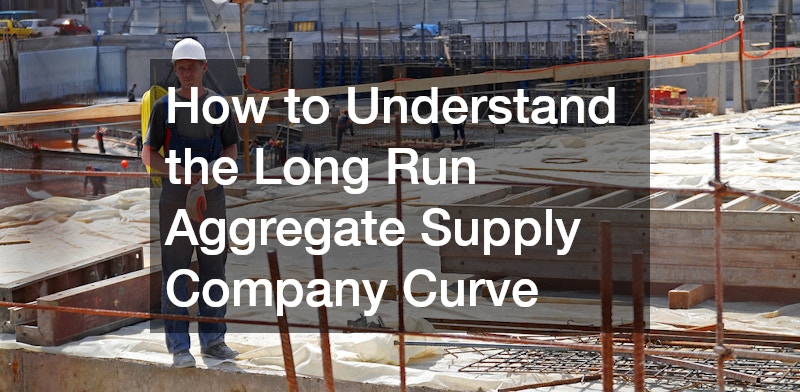
In today’s competitive economy, businesses across the construction and infrastructure sectors are constantly looking for ways to reduce production costs without compromising quality. One often overlooked strategy is using high-quality concrete aggregate supplies sourced from 100% recycled materials. These sustainable alternatives offer more than just environmental benefits—they also hold significant economic value. Understanding how this fits within the broader economic concept of the long run aggregate supply (LRAS) curve can help businesses make smarter, future-focused decisions.
What is the Long Run Aggregate Supply Curve?
In economics, the long run aggregate supply curve represents a country’s maximum sustainable output at full employment, where all resources are efficiently utilised. Unlike the short run, where prices and wages are sticky, the long run assumes that input costs adjust fully to output changes.
The LRAS is typically depicted as a vertical line, symbolising that an economy’s output is determined by resources, technology and productivity, not price levels.
For businesses, particularly those in construction or manufacturing, this macroeconomic concept has a microeconomic reflection. A firm’s productive capacity in the long term is defined by its access to quality inputs, the efficiency of its processes and the sustainability of its supply chains. And this is where sourcing materials from an aggregate supply company that offers 100% recycled concrete aggregate can make a tangible difference.
The Cost Advantage of Recycled Concrete Aggregate
Sourcing high-quality concrete aggregate from recycled materials helps reduce production costs in several key ways. First, recycled aggregates are often less expensive than virgin materials. Quarrying and transporting new aggregates require more energy and labour, resulting in higher prices. In contrast, recycled aggregates—made from reclaimed concrete debris—require significantly less processing and can often be sourced locally, further reducing transport and logistical expenses.
Second, the use of recycled aggregate supports circular economy principles. This reduces reliance on finite natural resources, which are becoming increasingly expensive due to regulatory constraints and environmental concerns. A forward-thinking aggregate supply firm understands these pressures and can offer clients a reliable, cost-effective alternative that supports both economic and environmental goals.
Enhancing Productivity & Sustainability
The long run aggregate supply curve shifts to the right when there’s an increase in the quantity or quality of productive resources, improvements in technology or better institutional structures. By integrating recycled concrete aggregate into construction processes, companies can effectively contribute to such a shift, at least within their sector.
High-quality recycled aggregates meet industry performance standards and can be used in a wide range of applications, from road base and drainage layers to structural concrete. Technological advancements in crushing, sorting and testing have improved the consistency and reliability of recycled products. When businesses partner with an aggregate supply company that prioritises quality control and compliance, they gain access to materials that perform on par with traditional options at a lower cost.
Furthermore, using recycled aggregates can contribute to sustainability certifications such as Green Star or IS Rating, which are increasingly valued in both public and private sector projects. This opens up new tender opportunities and can boost a company’s reputation and profitability in the long run.
Economic & Regulatory Incentives
Australian businesses are also beginning to benefit from supportive policy environments. Various states and territories are promoting the use of recycled materials through subsidies, procurement targets and landfill levies. These measures not only make recycled aggregates more competitive but also provide long-term cost stability in a market where virgin material prices are expected to continue rising.
For example, New South Wales and Victoria have implemented waste levies and resource recovery targets that effectively encourage construction firms to choose recycled over quarried materials. Working with an aggregate supply enterprise that is well-versed in these regulations ensures compliance and often provides additional advisory support to maximise cost savings and project eligibility.
Choosing the Right Aggregate Supply Firm

Not all recycled aggregates are created equal. The key to realising cost savings lies in choosing a reputable aggregate supply business with a proven track record in quality assurance and sustainability. Look for suppliers that:
- Comply with Australian Standards such as AS 2758.1 for concrete aggregates
- Have transparent testing and quality control procedures
- Offer clear documentation for sustainability certifications
- Provide delivery and logistical solutions tailored to your project’s scale and location
Establishing a long-term partnership with such a supplier can reduce procurement risks, ensure material consistency and streamline operations—all of which enhance productivity over time.
Aligning your procurement strategy with the principles behind the long-run aggregate supply curve isn’t just an academic exercise—it’s a practical approach to future-proofing your operations. By partnering with an aggregate supply company that delivers high-quality recycled products, businesses can reduce costs, enhance sustainability and strengthen their long-term production potential.


